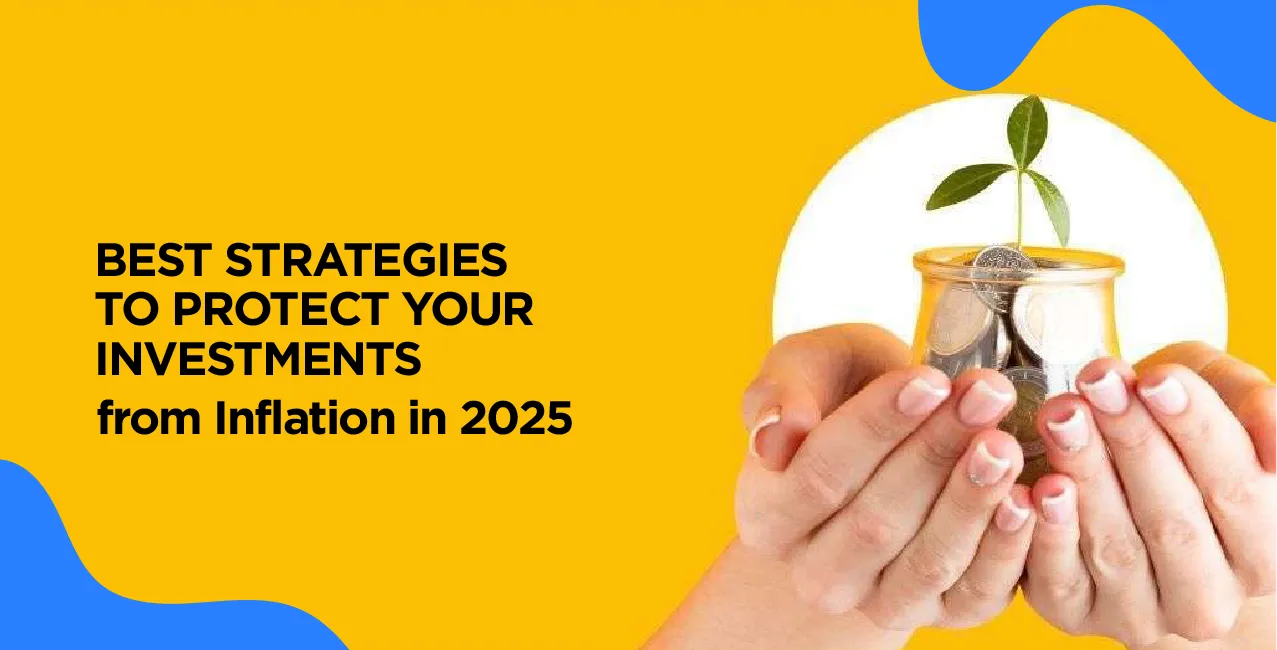
Author
LoansJagat Team
Read Time
8 Min
25 Mar 2025
Best Strategies to Protect Your Investments from Inflation in 2025
You have ₹1,00,000 saved up in 2020. With an average inflation rate of 5% per year, by 2025, the purchasing power of that money will decrease. This means that what ₹1,00,000 could buy in 2020 would require more money in 2025 due to rising prices.
In January 2025, India's retail inflation eased to a five-month low of 4.31%, primarily due to declining food costs.
While this indicates a positive trend, inflation remains a constant factor that can erode the value of your investments over time. Therefore, adopting strategies that protect your assets from inflation's impact in 2025 and beyond is crucial.
Protecting Your Investments from Inflation in 2025
Inflation eats away the value of money over time. Your wealth shrinks if your investments don’t grow at the same pace as inflation.
In India, where inflation fluctuates due to food prices, fuel costs, and global factors, innovative investment strategies can safeguard your money. By choosing the right options, you can ensure your savings grow rather than lose value over time.
Read More - Inflation Affects Your Savings
Diversify Across Asset Classes
Relying on one type of investment is risky. Asset classes—stocks, gold, real estate, and bonds—perform differently in various economic conditions. Spreading investments across these helps balance the impact of inflation.
Stocks: Over the long term, stock markets beat inflation. If inflation is 5%, but the stock market grows by 12%, your money still grows in real terms. For example, if you invest ₹5,00,000 in an equity mutual fund that gives a 12% annual return in 10 years, it can grow to ₹15,50,000, even after accounting for 5% inflation.
Gold: Gold is a traditional inflation hedge in India. In 2020, gold prices were around ₹50,000 per 10 grams, while in 2024, they crossed ₹65,000. Gold protects wealth during uncertain times.
- Fixed Deposits and Bonds: Traditional fixed deposits may not always beat inflation. If inflation is 6% and your FD gives 5.5%, you’re losing money. However, corporate or government bonds with higher returns can help balance this.
You need to mix different investments so that even if one underperforms, others compensate for it.
Invest in Inflation-Protected Securities (TIPS)
Inflation-protected securities (TIPS) are government-backed investments that adjust according to inflation. In India, these are known as inflation-indexed bonds (IIBs). These bonds increase their principal value when inflation rises, ensuring returns remain stable.
Here’s an example:
Investment Type | Returns (Annual) | Inflation Impact | Real Growth |
Fixed Deposit | 5.50% | 6% | -0.50% |
Inflation-Indexed Bond | 7% | 6% | 1% |
Stock Market | 12% | 6% | 6% |
Unlike FDs, inflation-indexed bonds protect against inflation that may provide negative real returns. Though stock markets give higher returns, bonds offer stability and predictability.
Consider Real Estate Investments
Property is a solid long-term investment that generally keeps pace with inflation. When inflation rises, property prices and rental incomes also increase. Investing in real estate ensures both appreciation and passive income.
Rental Income: Suppose you buy a ₹50,00,000 apartment and rent it out for ₹15,000 per month. If inflation increases at 5% annually, rents could rise to ₹19,000 in 5 years, protecting your purchasing power.
- Property Value Growth: If property prices in your city grow by 8% per year, your ₹50,00,000 home could be worth ₹73,00,000 in 5 years, staying ahead of inflation.
However, property investment needs careful planning. Choose growing locations, consider rental demand, and factor in loan interest rates before investing.
Allocate to Commodities and Precious Metals
Commodities, such as gold, silver, oil, and agricultural products, tend to rise in value when inflation is high. This is because when the cost of goods increases, the price of raw materials increases. Investing in commodities can help balance your portfolio during inflationary periods.
Gold and Silver: Gold is one of the most trusted inflation hedges in India. In 2019, gold was around ₹35,000 per 10 grams. By 2024, it had surged past ₹65,000. This shows how gold holds value over time. Silver also follows a similar pattern and is useful in industries, increasing its demand.
Oil and Energy: Rising fuel prices directly impact inflation. Investing in energy companies or oil ETFs can benefit from this trend. If crude oil prices go up, companies involved in oil production see higher profits.
- Agricultural Commodities: Crops like wheat, rice, and sugar have increasing demand and limited supply. Investing in commodity-based funds or stocks of agricultural companies can help balance inflation risks.
Many investors keep at least 5-10% of their portfolio in commodities to provide protection when inflation rises.
Focus on Dividend-Growth Stocks
Dividend-paying stocks provide two benefits: regular income and capital appreciation. Some companies consistently grow their dividends, helping investors keep up with inflation.
Here’s why dividend-growth stocks work:
Steady Income: Even if stock prices fluctuate, dividends provide cash flow. If you invest ₹10,00,000 in a company that pays a 5% dividend, you receive ₹50,000 annually. If dividends increase yearly, your income also grows.
- Long-Term Growth: Companies that regularly raise dividends often have strong financial health. Stocks like HDFC Bank, ITC, and Infosys have consistently increased dividends over the years.
Let’s compare two types of stocks:
Stock Type | Initial Investment | Dividend Yield | Annual Dividend | 5-Year Growth |
Non-Dividend Stock | ₹5,00,000 | 0% | ₹0 | ₹8,00,000 |
Dividend-Growth Stock | ₹5,00,000 | 5% | ₹25,000 | ₹9,00,000 (incl. dividends) |
A dividend-growth stock provides returns from price appreciation and gives cash flow, which you can reinvest or use for expenses.
Explore Alternative Investments
Traditional investments like stocks and bonds are not the only ways to protect money from inflation. Alternative investments, such as real estate investment trusts (REITs), peer-to-peer lending, and startup investing, provide unique ways to grow wealth.
Real Estate Investment Trusts (REITs): If buying property is too expensive, REITs allow you to invest in real estate without purchasing land or buildings. REITs own properties like malls, office spaces, and hotels, distributing rental income as dividends. A ₹1,00,000 investment in REITs can give annual returns of 8-12%, making it a strong inflation hedge.
Peer-to-Peer (P2P) Lending: P2P lending platforms allow individuals to lend money directly to borrowers at higher interest rates. Unlike FDs that offer 6-7%, P2P lending can generate returns of 10-15% annually. However, it involves higher risk.
- Startup investing: Investing in early-stage companies through platforms like AngelList can provide huge returns. If a startup grows successfully, a ₹50,000 investment can turn into ₹5,00,000 or more within a few years. However, startups also come with high risk.
Alternative investments add diversification and potential high returns, helping investors beat inflation effectively.
Optimise Debt Management
Debt can be a double-edged sword. Some loans help you grow wealth, while others drain your money. In times of high inflation, managing debt wisely is crucial.
Prioritise High-Interest Loans: Credit cards and personal loans charge 12-36% interest annually, much higher than inflation. Paying them off early saves money.
Consider Fixed-Rate Loans: If inflation rises, loans with floating interest rates (like home loans) become expensive. A fixed-rate loan locks in a stable EMI.
- Use Inflation to Your Advantage: If you have a home loan at 7% interest and inflation is 6%, the real cost of borrowing is low. If your property value increases faster than the loan interest, you benefit.
Example: Home Loan Repayment Strategy
Let’s say you have a ₹50,00,000 home loan at 8% interest for 20 years. Your EMI is around ₹41,800. If you make an extra payment of ₹10,000 per month, you can save ₹15,00,000 in interest and close the loan 6 years earlier.
Smart debt management means reducing high-interest debt and using low-cost debt for wealth creation.
Also Read - Impact of Inflation on Fixed Deposit
Maintain a Balanced Bond Portfolio
Bonds are stable investments, but they need careful selection during inflation. Fixed-rate bonds lose value when inflation rises, while inflation-protected bonds can offer better returns.
There are three main types of bonds to consider:
- Government Bonds: Indian government bonds offer safety and steady interest rates, usually 6-7% per year.
- Corporate Bonds: Large companies issue bonds that give higher returns (8-10%) but with some risk.
- Inflation-Indexed Bonds (IIBs): These bonds increase their payout when inflation rises, making them perfect for inflation protection.
Comparing Bonds During Inflation
Bond Type | Interest Rate | Inflation Impact | Risk Level |
Fixed-Rate Government Bond | 7% | Loses value if inflation rises | Low |
Corporate Bond | 9% | Can beat inflation but has company risk | Medium |
Inflation-Indexed Bond | 6-8% (adjusts with inflation) | Protects value | Low |
A balanced bond portfolio should have a mix of these bonds. If you hold only fixed-rate bonds, inflation can reduce your real
returns. Adding inflation-indexed bonds and corporate bonds can help you stay ahead.
Invest in High-Performing Sectors
Not all industries suffer from inflation. Some sectors grow faster than inflation, making them strong investments. By choosing the right industries, your portfolio can benefit even when prices rise.
Top Sectors to Invest in 2025
Technology & IT: Companies like TCS, Infosys, and Wipro benefit as businesses go digital. The Indian IT sector is expected to grow at 8-10% annually.
Pharma & Healthcare: Healthcare spending always rises. Investing in Sun Pharma, Dr Reddy’s, or Apollo Hospitals can provide stable growth.
Energy & Renewables: As energy demand rises, companies in solar, wind, and green energy will see growth.
- Consumer Goods (FMCG): Everyday products always sell, even during inflation. Stocks like HUL, ITC, and Nestlé are good inflation-proof choices.
Example: Investing in Technology
If you invested ₹1,00,000 in Infosys stock in 2015, by 2025, it would be worth around ₹6,00,000, thanks to steady growth. Investing in high-growth sectors ensures your money outpaces inflation.
Conclusion
Inflation is a reality, but smart investment strategies can help protect your wealth. By diversifying across asset classes, investing in inflation-protected securities, and allocating funds to real estate, commodities, and high-growth sectors, you can stay ahead of rising prices.
Managing debt wisely and maintaining a balanced bond portfolio ensures that your financial future remains secure.
No single investment works for everyone. The key is to spread risk, invest in assets that beat inflation, and adapt to market changes. With a well-planned strategy, you can protect your purchasing power and grow your wealth in 2025 and beyond. Start today and make your money work for you!
FAQs
1. How does inflation affect my savings?
Inflation reduces the purchasing power of money. If inflation is 6% per year, what costs ₹1,00,000 today may cost ₹1,06,000 next year, making your savings less valuable over time.
2. What is the safest way to protect money from inflation?
Investing in gold, real estate, inflation-indexed bonds, and dividend stocks can help protect your money from inflation.
3. Are fixed deposits good during inflation?
Fixed deposits may not always beat inflation. If inflation is higher than FD interest rates, your real returns could be negative. Choosing high-return corporate bonds or inflation-protected securities is better.
4. Why is gold considered a hedge against inflation?
Gold retains its value over time. When inflation rises, the price of gold generally increases, making it a safe store of wealth.
5. Should I take a home loan during inflation?
A home loan with a fixed interest rate can be beneficial if property prices increase faster than inflation. Extra loan payments can also reduce interest costs.
Other Informative Pages | |||
How to Rebalance Your Investment Portfolio for Maximum Returns | |||
About the Author

LoansJagat Team
‘Simplify Finance for Everyone.’ This is the common goal of our team, as we try to explain any topic with relatable examples. From personal to business finance, managing EMIs to becoming debt-free, we do extensive research on each and every parameter, so you don’t have to. Scroll up and have a look at what 15+ years of experience in the BFSI sector looks like.

Quick Apply Loan
Subscribe Now


